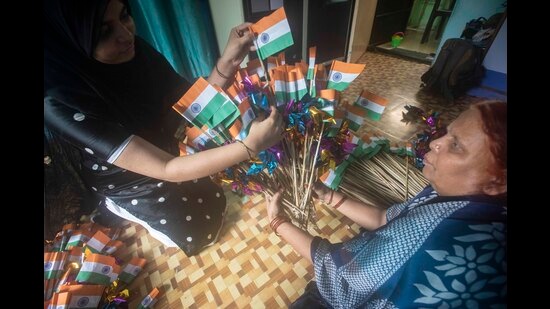Amrit Mahotsav inspires us to face new challenges
Even though we have much to be proud of, our society’s paradoxes still exist. Although everyone participated in the struggle for freedom as a united front, now there are voices from various forms of divisiveness
A transformational movement began this day exactly 80 years ago; the ruling class at the time first believed they had “crushed” it. They had forgotten a fundamental historical lesson: Sometimes, seemingly lesser occurrences result in significant transformations. By remembering those revolutionaries, we may honour our great predecessors today, on the 80th anniversary of the Quit India Movement.

On this day, Mohandas Karamchand Gandhi, while addressing a public meeting at Gowalia Tank Maidan (now August Kranti Maidan) in Mumbai, said: “Here is a mantra, a short one that I give you. You may imprint it on your hearts and let every breath of yours give expression to it. The mantra is: ‘Do or die.’ We shall either free India or die in the attempt; we shall not live to see the perpetuation of our slavery.” The mantra was going to have a significant effect in the days ahead.
Some individuals, however, think that this movement never really got started. The reason? All the members of the Congress Working Committee, and its entire national leadership, including Mahatma Gandhi, Jawaharlal Nehru, Sardar Vallabhbhai Patel, and Abul Kalam Azad, were detained and imprisoned on August 9 on charges of sedition the very next day. The British administration brutalised people excessively in the days that followed. Furious British officers detained more than 100,000 people. However, this non-violent movement steered clear of all expressions of anger. There was a local uproar after the major arrest, but it subsided soon. Indians, in the eyes of the colonial authorities, could neither do anything nor die. One reason why the British thought so was that the Hindu Mahasabha, Muslim League, and the princely states were supporting them. Some Congress leaders also believed that some of their own betrayed them and told British officers where influential leaders were in hiding.
There were more than 600 princely states in India at that time. The British Empire served as a sort of protector for these royals. They also believed that the agitation had failed due to the quick arrests of the movement’s leadership. They were mistaken. Through peaceful ways, this agitation quickly spread to turn into India’s national freedom struggle. On the other side, the period saw great unrest throughout the world. World War II was at its height. On December 7, 1941, America’s entry into the conflict demonstrated that there were now two distinct worlds, and the war would not end soon. Gandhi and his allies knew that the emergence of America would loosen the grip of the British Empire. Great Britain seemed to be paying a high price for World War II by that point.
The British were employing Indian soldiers in the conflict despite the Congress’s protests. Indian soldiers had a notable impact on World War I, fought between 1919 and 1923. They made the impossible possible with their bravery and sacrifice. Gandhi, at the time, backed the Empire as well, believing that the British would grant India Independence in exchange for the soldiers’ sacrifices. He was mistaken. The British government misled Indians during this time through the Cripps Mission and August Proposal. Indian troops served on the frontlines even during World War II. In this conflict, around 87,000 Indian soldiers lost their lives; 74,000 Indian soldiers had already died in World War I.
Their martyrdom sowed the seeds of resentment in every town and village. Above all, most of the population in the agrarian nation faced a food grain shortage. The musclemen of the zamindars employed horrifying means to collect taxes. The groundwork for the subsequent five years was built by this movement.
Returning to the present, the nation has progressed significantly in the 75 years since Independence. We didn’t have enough food grain to feed everyone until 40 years ago. The world is looking to India with optimism now when the Ukraine war has caused a food crisis. If there is a surplus of food grain, it is also true that 190 million people go without enough food daily. Even though we have much to be proud of, our society’s paradoxes still exist. Although everyone participated in the struggle for freedom as a united front, now there are voices from various forms of divisiveness.
Obviously, while the Amrit Mahotsav of Independence makes us proud, it also inspires us to face new challenges.
Shashi Shekhar is editor-in-chief, HindustanThe views expressed are personal
Continue reading with HT Premium Subscription




